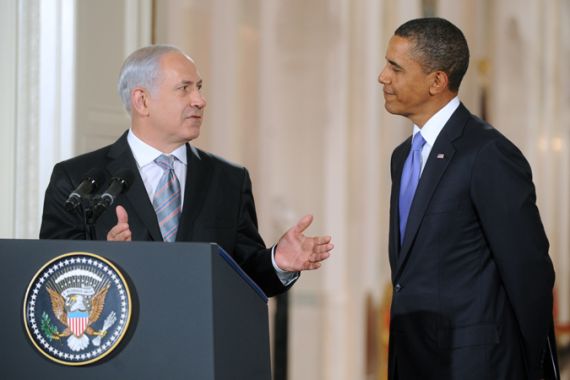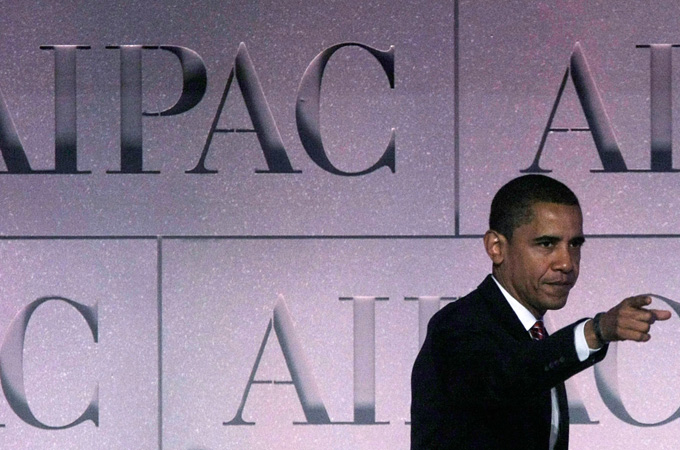Obama: getting ‘poned’ Bibi style
Without adopting a new approach, the Obama administration will fail in its quest to bring peace to Palestine/Israel.

 |
|
The Obama administration continues to be led on a leash, regarding the Middle East peace process [Getty] |
If you don’t have a child between 7 and 13 years old, you’re probably furrowing your brow right now, wondering what the word “pone” could possibly mean.
It hasn’t made it into respectable dictionaries yet; but it’s taken over the elementary schoolyards and playgrounds where I live. And there’s no better word to describe how well Israeli Prime Minister Netanyahu has played the Obama administration.
According to urban lore, “pone” was coined by young fans of the boy band the Jonas Brothers (who recently rocked Abu Dhabi in what was surely one of the stranger concerts in human history). In reality, the term comes from a common misspelling of the word “owned” as “pwned” in text and chat messages. It roughly translates into adult-speak as being completely “owning” by an opponent in a sport or game, to the point of humiliation. (“You got totally poned, dude,” is a common refrain around my house after a particularly one-sided basketball).
Considering the President’s well known skills on the hardwood, it’s doubtful Netanyahu could ‘pone’ Obama in a game of one-on-one basketball. But on the field of diplomacy the Israeli continues to school his American opponent – and have no doubt about it, the US and Israel might be close “allies,” but Obama is being treated as little better than an opponent to be vanquished rather than a patron to be respected.
Despite the immense power disparity in the American’s favour, it’s not hard to figure out why the Israelis continuously win such lopsided victories, most recently in the agreement of the Americans to provided yet more billions of dollars worth of advanced fighter jets in return for another limited (read: illusionary) settlement freeze.
The President might be from Chicago, but you can’t play the kind of rough and tumble politics for which his home town is famous if the game is fixed and referees are on the take.
With the US ‘weapondollar-petrodollar’ complex having a stranglehold on US policy-making in the Middle East and Congress and the media literally owned by conservative supporters of Israel, it’s difficult to imagine how even Phil Jackson could design a playbook to overcome the political realities that have hamstrung President Obama in his quest to bring peace to Israel/Palestine.
Time to change the game
One underlying reason for this difficulty lies in the nature of the conflict itself. The basic problem of the Israeli-Palestinian conflict has always been, and remains, two-fold: It is a zero-sum conflict over territory whose two opponents ground their identities in the notion of exclusive control of territory by one ethnonational group.
This link between ethnicity and exclusive control of identity has constituted the standard (although not the only) model of sovereignty in the modern world, defining the political norm for hundreds of years.
Within Zionism and later Israeli politics, the Left, as represented by the Labour movement, has always failed to lead the Jewish national community – despite a century of lofty rhetoric – precisely because in the end Labour Zionism’s territorial imperatives have trumped progressive ideals.
And so it was the Labour movement that envisioned the “conquest of land” that became a cornerstone of Jewish settlement before and after 1948, while the Labour Party presided over the most damaging expansion of Israeli settlements, during the Oslo years.
Obama came into office hoping to change the rules governing US diplomacy towards Israel. But his efforts were doomed as he quickly ran afoul of the ironclad rules governing a century of zero-sum ethnoterritorial conflict.
Entering the diplomatic ring with neither the right equipment nor a team who understood these rules, the Administration was quite literally poned by the Israelis when it tried early on to get the Netanyahu government to agree to a settlement freeze, suffering a blow from which it has yet to recover.
Yet the President is by no means out of the game. What he needs to realise, however, is that if he can’t change the game he can change the rules surrounding what constitutes a goal, and through it, victory-or rather peace-in the conflict.
Moving beyond sovereignty-territory axis
It might seem strange to imagine a non-territorially grounded resolution to the Israeli-Palestinian conflict, but there is in fact nothing to say that such a political-territorial arrangement is the only viable model for Israeli and Palestinian identities to take, or even the best one.
Indeed, various alternative forms of identity have been imagined by members o the two communities for almost a century, most of them focusing on shared sovereignty-either a binational or single-state solution.
The problem with such alternative solutions is that while most Palestinians would welcome them, hardly any Israelis would agree to them as long as they were offered in the context of a territorially grounded notion of sovereignty. The reason is clear: such an arrangement would very quickly mean the end of a Jewish state, with Jews living as a minority in a country they previously controlled.
It would seem that any viable solution in the near term would still have to involve two sovereign states “living side by side,” as the much abused phrase describes it.
Yet a two-state solution based on the Oslo-style land-for-peace formula is practically impossible, as Israel has achieved such a deep presence in the West Bank-one that it continues to expand, despite itself-that territorial separation is (and has been for a generation) all but impossible.
The conundrum for those working for peace, then, is how to design a solution that would retain two-states while moving beyond the zero-sum problematic that has always dragged down the two-state solution.
Solving a difficult puzzle
A difficult puzzle to be sure, however for the last two years a group of Palestinian and Israeli scholars and policy-makers, with the assistance of a former high-ranking Swedish diplomat with a long history of involvement in regional peace efforts have been working hard to solve it (here it’s worth recalling that the “Oslo” peace process actually started in Stockholm, before being handed over by Swedish diplomats to their Norwegian counterparts after a new government came to power that didn’t support their back channel efforts).
Called the Parallel States Project, the group, whose roster includes former senior settlement leaders as well as Palestinians with longstanding ties to the PLO leadership, early on concluded that nothing short of a wholesale reimagining of Israeli and Palestinian identities in a manner that moved beyond territorial sovereignty while allowing each community to identify and remain loyal to its own state and identity would lift the impasse that has for so long doomed negotiations.
The core component of a Parallel States solution is the move from a two-dimensional notion of sovereignty based on fixed borders, to parallel, or better, overlapping notions of sovereignty, in which Israeli and Palestinian states could each claim sovereignty over the whole territory in a manner that would not infringe on the rights and claims of the other state, or its citizens.
How to pull off such a seemingly impossible magic trick? The answer is as simple as it is profound: Disassemble the triangle linking the citizen to her or his state through the particular piece of territory – Tel Aviv or Nablus, Ariel or Jaffa – on which he or she lives, and replace it with a direct link between the individual citizen and her or his respective state that would holds firm regardless of whether one is a Palestinian living in Herzliyya or a Jewish Israeli living in Gaza.
Specifically, the two most important implications of a parallel states solution are that settlements are no longer an obstacle to peace and Palestinians could implement the Right of Return because. Enabling both is the ability of Jews and Palestinians to live anywhere in the space of historical Palestine/Eretz Yisrael in a parallel states scenario.
Jews could continue to live in their biblical heartland of the West Bank without being settlers (this accounts or why several of the core members of the group are active members of the settlement movement), while Palestinians dislocated by settlements would receive compensation and/or previously Israeli controlled land.
Palestinians, including the millions of refugees whose right of return is perhaps the single biggest obstacle to peace, could also live anywhere within the 1967 borders of Israel because no matter how many Palestinian lived there it would not change the demographic balance of the Jewish state, whose demographic basis would not be tied to territory. And of course, both peoples could live throughout Jerusalem, returning the city to the more demographically checkered and cosmopolitan identity it had developed before 1948.
And so the three biggest obstacles to peace – settlements and refugees and Jerusalem – would be resolved through a parallel states solution.
Of course, a parallel states solution would not be easy. Numerous considerations – from how to develop the Palestinian economy in a way the finally gives it significant autonomy while retaining strong ties both to Israel and the larger world, to developing the unique security arrangements necessary to satisfy Israel’s focus on strategic and personal security and Palestinians’ need for physical security and freedom from occupation. The legal systems of both states would also have to be harmonised.
But if the totality of the innovations necessary to create a parallel states structure is unprecedented, the fact is that most of the individual changes are not, as they’ve already been conceived of and even implemented (with varying levels of success to be sure) in conflict zones as diverse as Cyprus and Nagorno Karabagh.
What is needed more than outside-the-box thinking is outside-the-box leadership. And while Israelis and Palestinians could desperately use a new and courageous generation of leaders, the need is nowhere greater than on the part of an Obama Administration which has until now exhibited a tragic predilection for embracing the status quo while calling it change.
If the President is willing to take the risk of reaching out for creative solutions to this interminable conflict, there is a chance he will help enable the kind of change Israelis and Palestinians can actually believe in. If not, he’ll continue to get poned by Netanyahu and his American allies, and we will all be the losers for it.
Mark LeVine is a professor of history at UC Irvine and senior visiting researcher at the Centre for Middle Eastern Studies at Lund University in Sweden. His most recent books are Heavy Metal Islam (Random House) and Impossible Peace: Israel/Palestine Since 1989 (Zed Books).
The views expressed in this article are the author’s own and do not necessarily reflect Al Jazeera’s editorial policy.
